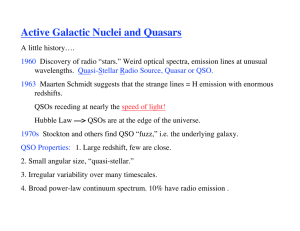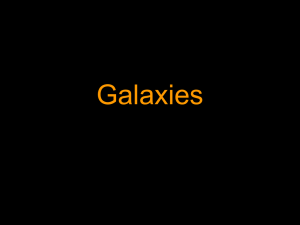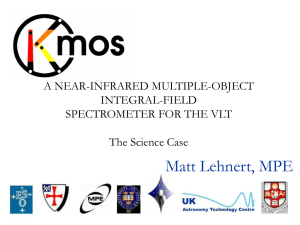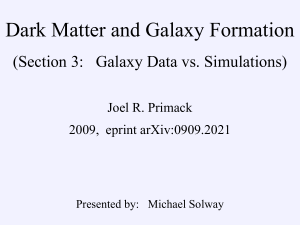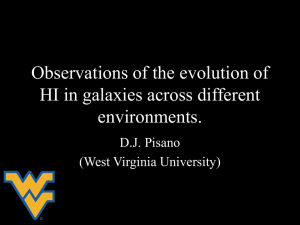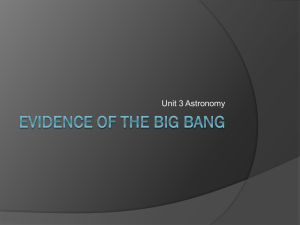LAMOST Extragalactic Surveys (LEGAS)
advertisement
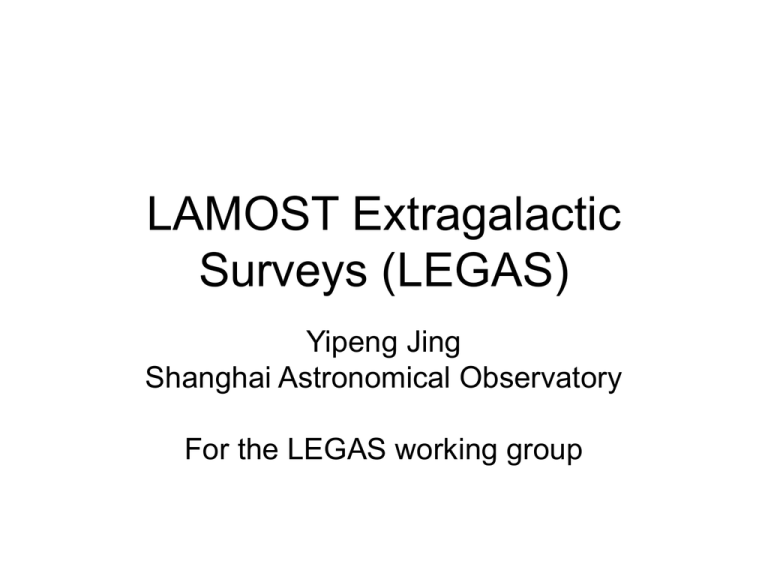
LAMOST Extragalactic Surveys (LEGAS) Yipeng Jing Shanghai Astronomical Observatory For the LEGAS working group Main Parameters • Main function spectroscopic sky survey • Effective aperture 4 meter • Focal length 20 meter • Angular FOV 5(linear FOV 1.75-meter) • Image quality 80% energy encircled in 2.0 acrsec • Number of optical fiber 4000 • Observing sky area -10 +90 24,000 square degrees • Spectral resolution • Survey capability 1-0.25nm taking spectral resolution 1nm, integration time 1.5 hours, • Size of fiber max bj magnitude: 20.5m at Xinlong 3.30 arcsec( 320m linear) Task: make a proposal Contributions to LEGAS proposal • Working Group: – Members: Jing Yipeng, Zhou Xu, Chen Xuelei, Wu Hong, Wu Xuebing, Zheng Xianzhong,Shen Shiyin, Wang Junxian, Li Cheng, Fan Xiaohui – LAMOST engineering contacts: Zhang Haotong, Zhang Yanxia, Luo Ali, Chen Jianjun. • Wang Tinggui, Chu Yaoquan, Kong Xu, Yang Xiaohu, Zheng Zheng, Zhang Pengjie, Yuan Weimin, Gao Yu, Jun Pan, Zhou Hongyan, Shang Zhaohui, Lu Youjun, XiaXiaoyang, Liu Fengshan, Wang Jianling, Liang Yanchun, Zhang Wei, Fan Zuhui, Zhang Xinmin, Li Hong, Wang Yougang, Wu Fengquan…..(incomplete) • 60 staff members + >120 students and postdocs in China are expected to analyze the LEGAS data Cutting-edge problems for LAMOST (I) • The physical properties of dark energy, the neutrino mass, the physical properties of initial density fluctuation in the early Universe etc, which can be addressed with a better determination of large scale structures on scales 100 h−1Mpc; • The generic predictions of the cold dark matter model, such as dark matter halos and especially subhalos around galaxies, which can be tested with a bigger sample of groups of galaxies combined with future deep imaging surveys (e.g. Pan-Starrs and LSST) ; Cutting-edge problems for LAMOST (II) • The physical processes of galaxy formation, such as galaxy interaction, galaxy merging, energy feedback etc, which can be addressed with a denser sampling of structures to a fainter luminosity limit in our local Universe; • The growth of supermassive black holes and the co-evolution with their host galaxies, which can be addressed with a better sampling of quasars at z=1-3 and a larger sample of low-z AGNs. Proposed LEGAS Surveys (the most optimistic) • Spectroscopic Surveys of galaxies and QSOs in the NGC of 8000 sq degrees (SDSS sky) and in the SGC of about 3500 sq degrees: – LAMOST Galaxy Deep Survey; 2.3 million of r<19.5 in 3400 sq deg; – LAMOST Galaxy Shallow Survey; 2.4 million of r<19.0 in the rest 8100 sq deg; – LAMOST Early Massive Galaxy (EMG) Survey; 1 million of ideV<20.0 ; – LAMOST Quasar Survey; 0.4 million of i<20.5; • A data base of 6 million extragalactic spectra Pilot surveys • 140 square degrees sky areas at high Galactic latitude – r<19.5 galaxies (800/deg**2) – i<20 EMGs (100/deg**2) – 19.1<i<20.5 point sources (2000/deg**2) 40 dark nights • 120 regions of rich clusters for early science +calibration in ALL LEGAS region • Determine how many transparent nights are available for LEGAS each year? Another LEGAS proposal • The current one: – Competition from SDSS III on EMGs – According to the telescope design parameters • A “descoped” one, but still unique and very powerful: – Shallow survey (r<19) in 11000 square degrees (3.8 million) – QSO survey (19.1<i<20.5) (0.6 million) – Exposure time: 30 minutes – 3.3 years; 90 % complete for galaxies and 100% complete for QSOs; fiber usage rate is 56% Shen Shiyin provides Science Case 1. Clustering of galaxies on the largest ever scales • Will combine LRGs, QSOs and galaxy samples to explore the clustering of galaxies on large scales (>50 Mpc/h), including BAO. The results will give new constraints on dark energy, inflation theories, Non-Gaussianity, modified gravity, and neutrinos mass; Simulations of NGC EMGs 距今42亿年 SLOAN 2 Two-point CF SLOAN 2 LAMOST Cheng LI 距今67亿年 LAMOST 赤道两侧3度范围内的亮红 星系的分布情况(模拟) Constraining the EOS of dark energy, e.g.,w(z)=w0+w1 z/(1+z) Wang,X, Chen,X et al. Hong LI et al. Science Case 2. Delineate filaments and study the environment dependence of galaxies Zhang et al. (2009) Case 3. Formation of dwarf galaxies • Filamentary structures in the Universe are delineated with the dense sampling; • Understanding why dwarf galaxies have (or do not have ) formed, compared with LCDM (feedback processes) • May constrain the properties of dark matter particles LAMOST主星系样本预研究 距今24亿年 星 系 的 分 布 SLOAN SLOAN 距今49亿年 LAMOST LAMOST 暗 星 系 样 本 的 两 点 相 关 函 数 Mo et al. (2005) Distribution of dwarf galaxies(to ALFALFA HI limit): CDM vs Warm dark matter(m=1kev); halo mass about 10**10 M_sun/h Zavala, Jing, et al 2009, ApJ Case 4. quantify dark matter distribution with groups • Understanding galaxy property and evolution in dense environments • Quantifying dark matter distribution within groups; • Combining Pan Starrs or LSST, may be feasible to explore subhalos Case 5: Reveal the evolution of galaxies in the last 4 billion years (15 times GAMA) 4 billion years LAMOST Case 6: HOD of different galaxies • Measuring the clustering and abundance of galaxies with different properties; • Obtain Occupation Distribution of different galaxies in dark matter Halos (HOD) • Study the evolution of galaxies from the HOD at different redshifts HOD method: assuming N galaxies in halo of mass M; First applied to Las Campanas Redshift survey, getting alpha= 0.09 Jing, Mo, Boerner 1998, ApJ, 494, 1 不同质量暗物质晕内部的 星系光度函数 Conditional luminosity functions of galaxies inferred from the best-fit HOD parameters for the luminosity-threshold samples, shown at three different halo mass scales Idit Zehavi et al., ApJ, 630:1–27, 2005 ; Yang et al 2003 for 2dF (a)亮红星系的投 影两点相关函数; (b)不同质量暗物 质晕内部的亮红星系 数目等 (c)卫星星系的比 例 (d) Projected two-point auto-correlation functions and bestfit HODs for the two luminosity-threshold LRG samples. Zheng Zheng ,…,JYP, et al., to be published Case 7: QSO Luminosity Function and evolution • obtain the most accurate quasar luminosity function, and to understand better about the black hole assambly from z = 3 • Will probably detect the luminosity dependence of QSO clustering, and be very powerful to study the coevolution of galaxies and central black holes Will be an ideal sample to explore BAO and LSS at z=2, for constraining DE and physics of the Early Universe • Richards,G Case 8: uncover obscured QSOs • Since part of the QSO sample will be based on UKIDSS-SDSS , it is very useful for studying obscured quasars, testing the unified model of AGN and constraining the growth history of super massive black holes; • These cases are only examples!!! The list is not exclusive • In SDSS, only half of the discoveries had been anticipated Final Remarks and next steps • SDSS II and 2DF have made great achievements in studying galaxy formation and cosmology. • LAMOST, if can reach its design specifications, will definitely make many remarkable achievements in extragalactic astronomy in the post-SDSS(II) era; The input sources only include galaxy(r<19) and QSO(i<20.5). There are about 3.8 million galaxies and 0.6 million QSOs, each of them is set with an exposure time 0.5h. It takes about 3 years and 3 months to reach the completeness of 90%. The average fiber usage is 56%. Since the priority of QSO is higher than galaxy, the completeness of QSO is about 100%. The surveys will be elaborated after the pilot survey data Thank you!



